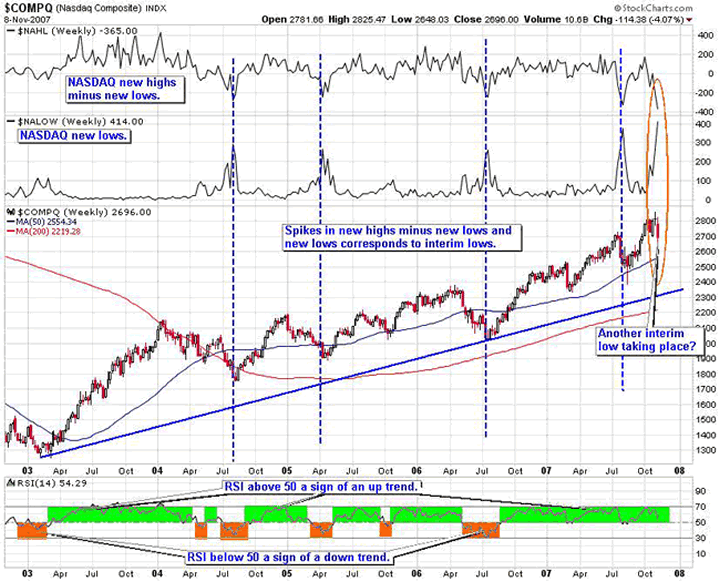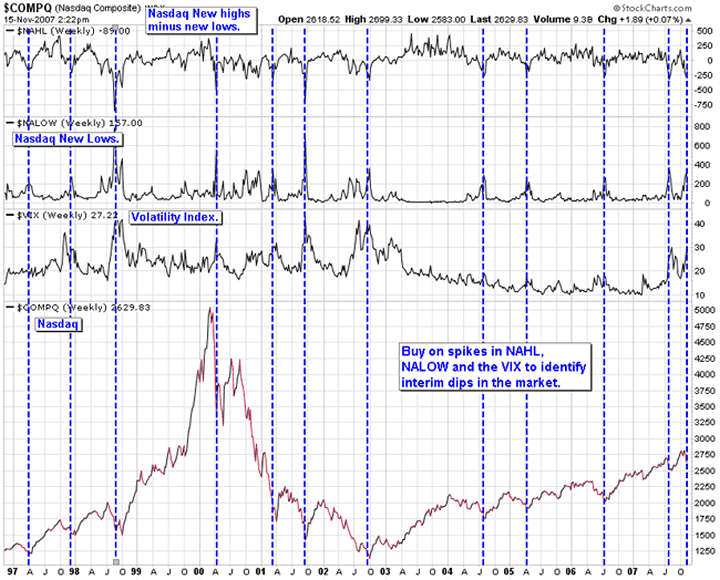Is the NASDAQ Bull Market Over?
Stock-Markets / Tech Stocks Nov 17, 2007 - 02:39 AM GMTBy: Hans_Wagner

 Recently, the NASDAQ has been outperforming all the other indexes including the DJIA and the S&P. However, the recent pull back in the market raises the question are we seeing another buyable low in the NASDAQ or is this the start of a more significant move down. Let's look at a couple of charts to see what they might tell us.
Recently, the NASDAQ has been outperforming all the other indexes including the DJIA and the S&P. However, the recent pull back in the market raises the question are we seeing another buyable low in the NASDAQ or is this the start of a more significant move down. Let's look at a couple of charts to see what they might tell us.
The NAHL and NALOW Indicators
The NAHL indicator is the NASDAQ new highs minus the new lows, while the NALOW is the NASDAQ new lows. In the past they have been useful to identify when there have been new lows, especially during the last five year bull market. The chart shows a weekly plot of the NASDAQ for the last five years with the corresponding plots of the NAHL and the NALOW. Notice that whenever there was a spike in both indicators, we also observed an interim low in the NASDAQ. This implies that these two indicators were quite helpful in identifying an interim low in the NASDAQ when the spike reached its low or high point and then began returning back to normal.

After the close on Friday November 9, 2007 we are observing another spike in both indicators as the NASDAQ falls. So is another interim low in the NASDAQ taking place or is this a more significant move down? First of all the rising trend line has bee acting as support and needs to be broken before a new down trend is in place. Also, the RSI is still indicating an up trend is in place, though this could change. At this point we cannot determine if the spikes are a sign of an interim low or a sign of a more significant move down.
Long Term View
If we expand the chart above to ten years, maybe it will help us to make a better assessment. Here we see the significant move up on the NASDAQ that ended in 2000. During the move up in 1999 the NAHL and NALOW spikes occurred very near interim lows as well. This leads one to believe that these indicators are very useful to identify the best opportunities to buy on dips in the price of the market.

The chart below adds what is known as the Volatility index or VIX. Whenever there is a spike up in the VIX we also see this as a sign on another interim low. It is always comforting to have three indicators acting together to help identify key turning points in the market, even if the VIX is measuring the options volatility for the S&P 500 and not the NASDAQ. It still works.

So what does all this tell us about whether this move down is an interim dip or the end of the bull market for the NASDAQ? Well, we cannot tell if the bull market is over. However, the chart below is definitely useful. It shows ten years of the NASDAQ with the five year bull market forming what some might call an ascending triangle as well as a rising channel.
According to the Encyclopedia of Chart Patterns (Wiley Trading) by Thomas N. Bulkowski the ascending triangle is one of the top five best performing bullish formations, though the chart below does not meet the criteria for an ascending triangle as defined by the Encyclopedia of Chart Patterns (Wiley Trading) . However the rising channel could be interrupted as a Measured Move Up, another successful formation as defined by Bulkowski's book.
In the chart below the key to knowing if the bull market is over is whether the 78 week (18 month) exponential moving average and the rising trend line are broken to the down side. MACD below zero helps to confirm the break of the bull market. As you can see we have not broken down yet, so technically we are experiencing an interim dip and not an end of the bull market. However, if the market continues to fall, then everything is likely to change.

The Bottom Line
Buying on dips is a proven strategy to help beat the market. Investors who follow the strategy must decide if the pull back is just another dip in the overall bull trend or is it the beginning of a new bear market. It helps to know what is driving the market up so when it turns down you can make an assessment of what might happen.
For example, the recent rise in the NASDAQ has been driven by the four horsemen of technology: Apple, Amazon, Google, and Research in Motion. When they started to go down they brought the NASDAQ with them. This is healthy as no market can depend on a few stocks to carry it up. Now everyone can focus on the more important factors like the economy, interest rates and company fundamentals to help understand if the bull market is over, in addition to the charts.
By Hans Wagner
tradingonlinemarkets.com
My Name is Hans Wagner and as a long time investor, I was fortunate to retire at 55. I believe you can employ simple investment principles to find and evaluate companies before committing one's hard earned money. Recently, after my children and their friends graduated from college, I found my self helping them to learn about the stock market and investing in stocks. As a result I created a website that provides a growing set of information on many investing topics along with sample portfolios that consistently beat the market at http://www.tradingonlinemarkets.com/
Hans Wagner Archive |
© 2005-2022 http://www.MarketOracle.co.uk - The Market Oracle is a FREE Daily Financial Markets Analysis & Forecasting online publication.


